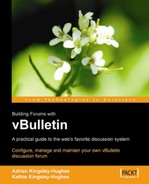In this book, you will find a number of styles of text that distinguish between different kinds of information. Here are some examples of these styles, and an explanation of their meaning.
There are three styles for code. Code words in text are shown as follows: "On most installations the database server is located on the same computer as the web server, in which case the address should be set to localhost."
A block of code will be set as follows:
<meta http-equiv="Cache-Control" content="no-cache" />
<!-- end no cache headers -->
<title><phrase 1="$vboptions[bbtitle]">$vbphrase [x_powered_by_vbulletin]</phrase></title>
$headinclude
When we wish to draw your attention to a particular part of a code block, the relevant lines or items will be made bold:
<meta http-equiv="Cache-Control" content="no-cache" />
<!-- end no cache headers -->
<title><phrase 1="$vboptions[bbtitle]">$vbphrase [x_powered_by_vbulletin]</phrase></title>
$headinclude
Any command-line input and output is written as follows:
GRANT ALL ON vb_database.* TO vb_user@localhost IDENTIFIED BY 'password';
New terms and important words are introduced in a bold-type font. Words that you see on the screen, in menus or dialog boxes for example, appear in our text like this: "clicking the Next button moves you to the next screen".
